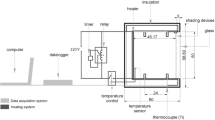Abstract
The Solar Heat Gain Coefficient (SHGC) is one of the energy loss factors in buildings, which affects a cooling load significantly. A variety of shading devices and high-performance windows have already been developed and applied to a large number of buildings to reduce a cooling load. However, performance evaluation on these shading devices and high-performance windows has depended on calculation via mathematical models and simulations. These evaluation methods have limits when reflecting heat characteristics of the ever-increasing complexity and development of window systems accurately in a realistic way. Thus, it is critically necessary to verify performance evaluation results through actual measure. The purpose of this paper is to measure the SHGC of various types of windows and shading devices and to analyze the difference between the calculated value and the measured value. The experimental result is as follows. SHGC of venetian blind is lower than SHGC of roll screen and Triple shade. The higher the glass SHGC was, the higher the SHGC reduction rate was under the same condition. The larger the slot angle was, the greater the SHGC performance improved. The analysis result on measured and calculated values showed that a mean different ratio was 4.86 %, which was matched within 5 % of the deviation rate. However, the different ratio tended to increase as the complexity of structures and types of windows increased.








Similar content being viewed by others
References
E. Jea-Young, An experimental study for improving the reliability of the solar heat gain coefficient test method (Inha University, Incheon, 2016)
ISO 15099, Thermal performance of windows, doors and shading devices—detailed calculations (2003)
T.E. Kuhn, State of the art of advanced solar control devices for buildings. Solar Energy 154, 112–133 (2017)
B. Bueno, J.M. Cejudo-Lopez, T.E. Kuhn, A general method to evaluate the thermal impact of complex fenestration systems in building zones. Energy Buildings 155, 43–53 (2017)
M. An, Calculating SHGC for shading devices according to the distance between window glazing and shading (Hanyang University, Seoul, 2016)
S. Lu, Z. Li, Q. Zhao, F. Jiang, Modified calculation of solar heat gain coefficient in glazing façade buildings. Energy Procedia. 122, 151–156 (2017)
J.H. Klems, Measurement of fenestration net energy performance: consideration leading to development of the mobile window thermal test (MoWiTT) facility. J. Sol. Energy Eng. 110(3), 1–41 (1988)
H. Simmler, B. Binder, Experimental and numerical determination of the total solar energy transmittance of glazing with venetian blind shading. Build. Environ. 43, 197–204 (2008)
D.L. Marinoski, S. Güths, R. Lamberts, Development of a calorimeter for determination of the solar factor of architectural glass and fenestrations. Build. Environ. 47, 232–242 (2012)
D.B. Tait, Solar heat gain coefficients for high-mass glazing blocks. ASHRAE Trans. 112, 142–150 (2006)
S.J. Harrison, M.R. Collins., Queen’s university solar calorimeter—design, calibration, and operating procedures, Present. at Solar Energy. Society of Canada Conference (1999)
C.A. Guemard, W.C. Dupont, Spectral effects on the transmittances solar heat gain and performance rating of glazing systems. Solar Energy 83, 940–953 (2009)
S.J. Harrison, S.J. Van Wonderen, A test method for the determination of window solar heat gain coefficient. ASHRAE Trans. 100, 1057–1064 (1994)
F. Chen, S.K. Wittkopf, P.K. Ng, H. Du, Solar heat gain coefficient measurement of semi-transparent photovoltaic modules with indoor calorimetric hot box and solar simulator. Energy Build. 53, 74–84 (2012)
T.E. Kuhn, C. Bühler, W.J. Platzer, Evaluation of overheating protection with sun-shading systems. Solar Energy 69, 59–74 (2000)
C. Kurayama, Development of a measurement system for SHGC and U-value for fenestration and shading system Part 1. J. Environ. Eng. 604, 15–22 (2006)
J.H. Klems, J.L. Warner, G.O. Kelley, A comparison between calculated and measured SHGC for complex fenestration systems (1995)
T. Kim, J. Kang, G. Choi, H. Choi, Evaluation of solar heat gain coefficient of shading device integrated with window using solar simulator, The society of air-conditioning and Refrig. Eng. Korea, 642–645 (2014)
J. Kang, Analysis on the research trends for establishing solar heat gain coefficient measurement method of window. Korean Inst. Archit. Sustain. Environ. Build. Syst. 245–248 (2013)
T. Kim, H. Choi, J. Park, An analysis of test method and measurement apparatus for the solar heat gain coefficient evaluation method of fenestration system. Korean Inst. Archit. Sustain. Environ. Build. Syst. 8, 4 (2014)
J. Jitae, An experimental method for SHGC assessment of complex fenestration (Sungkyunkwan University, Seoul, 2016)
ISO 19467, Thermal performance of windows and doors-determination of solar heat gain coefficient using solar simulator (2017)
KS L 9107 Testing method for the determination of solar heat gain coefficient of fenestration product using solar simulator (2014)
Acknowledgments
This work is supported by the Korea Agency for Infrastructure Technology Advancement (KAIA) grant funded by the Ministry of Land, Infrastructure and Transport (Grant 20AUDP-B151640-02).
Author information
Authors and Affiliations
Corresponding author
Ethics declarations
Conflicts of interest
The authors declare no conflicts of interest.
Additional information
Publisher's Note
Springer Nature remains neutral with regard to jurisdictional claims in published maps and institutional affiliations.
Rights and permissions
About this article
Cite this article
Lee, S., Kang, JS., Choi, HJ. et al. Study on SHGC Calculation and Measurement of Window Installed with Shading Device. Int J Thermophys 41, 106 (2020). https://doi.org/10.1007/s10765-020-02684-x
Received:
Accepted:
Published:
DOI: https://doi.org/10.1007/s10765-020-02684-x




